|
Notes: Initially a station was only provided on the Tooting line, this was called Lower Merton, the brick built stationmasters house which incorporated a book office was sited on the up platform. The building had a small canopy over the platform and a second canopy at the front of the station. There was a brick waiting shelter on the down platform. No footbridge was provided so passengers wanting the reach the down platform had to walk across the track.
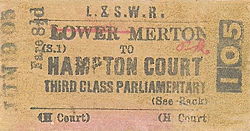 |
The station was built in anticipation of the development of John Innes' Merton Park Estate where the laying out of roads started in the early 1870's. Progress with the estate was slow and John Innes was instrumental in obtaining improvements to the station. A new platform was opened on the Mitcham line on 1st November 1870 and in response to his persistence the name was |
changed to the more socially acceptable Merton Park from 1st September 1887. No buildings were provided on the Mitcham platform so any passengers wanting shelter had to use the small shelter on the down Tooting platform. The station was called Merton Park Halt in timetables and on tickets between 1918 - 1925. During this period the station was unstaffed.
The Tooting platforms closed as an economy measure during WW1 on 1st January 1917, reopening on 27th August 1923. After closure of the Tooting line to passengers on 3rd March 1929 the line remained busy for freight. The junction at the Tooting end was severed in 1934 and the up line was lifted, the down line being worked as a long siding from Merton Park. Passengers for the Mitcham line now had to cross two disused platforms to reach their trains. The freight line closed on 1st May 1975 and the track was quickly lifted. A temporary wooden walkway was then provided so that passengers could cross the track bed more easily this was later replaced by a fenced earth walkway.
In the 1960's the LBSCR nameboards survived on the Tooting platforms with metal letters displayed on a wooden background. No similar large running in boards were ever provided on the Mitcham platform. In the late 1970's the nameboards were removed and the waiting shelter was demolished but the main building remained in use and continued to offer booking facilities. It was eventually closed and by the closure of the line in 1997 was in avery dilapidated state, daubed an graffiti and partly burned out; it was little more than a ruin. The signalbox on Kingston Road was also taken out of use in 1982.
| South of Merton Park Station a long metal lattice footbridge spanned both lines and giving access to a local playing field. The footbridge remained intact for many years after closure of the Tooting line but was eventually shortened in the 1980's so it just crossed the Mitcham line. After closure in 1997 the remaining section of the footbridge was dismantled & re-erected |
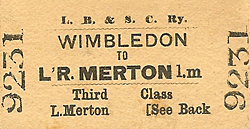 |
at Corfe Castle Station in Dorset, a station that never had a footbridge.
The Merton Park station building has now been fully restored as a private house retaining its awning at the front of the building. A new housing development has been build on the south end of the tooting platforms although a short overgrown section of the down platform survives in what is now a nature reserve.
BRIEF HISTORY OF THE WIMBLEDON - WEST CROYDON LINE
Before the coming of the railways the River Wandle was very heavily industrialised with 38 water mills and factories along its short length between Wandsworth and Croydon. As the river was not navigable, the mill owners required a means of transport for their goods so the Surrey Iron Railway was built between Wandsworth and Croydon. This was the earliest public railway in the London area and the first railway to receive parliamentary sanction in 1801. The 4' gauge double track horse drawn iron plateway was built by William Jessop and opened on 26th July 1803. The line was later extended south as the Croydon Merstham and Godstone Railway terminating at underground stone quarries at Merstham.
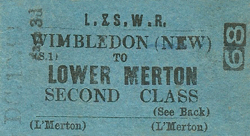 |
The line was never profitable as much of the traffic from Croydon used the Croydon Canal which opened in 1809 terminating at a basin adjacent to the Surrey Iron Railway at what is now West Croydon station. After 1825, the company paid no dividend. Early in 1844 there was a proposal by the London and Brighton to use the former track bed of the Surrey |
Iron Railway and the CM & GR to reach a new terminus at Waterloo Bridge from its existing Brighton line at Purley and in August that year the London & South Western Railway took an option to buy the SIR track bed but neither scheme was proceeded with and the SIR was eventually dissolved on 3rd August 1846 and the track bed reverted to agricultural use.
It wasn't long before there were further proposals promoted by local interests. One of these was the Mitcham & South Western Junction Railway running from Mitcham Green to the LSWR at Earlsfield. This was opposed by the LSWR but eventually an independent scheme to build a line from Wimbledon to Croydon was approved with the LSWR leasing the line between Wimbledon and Mitcham and the LBSCR leasing the remainder to a junction with its own line at West Croydon. The LSWR eventually pulled out of the scheme and the Wimbledon & Croydon Railway received its act in 1853 with a provision for working arrangements with the LSWR.
| The line was built by local Mitcham engineer George Parker Bidder and after two postponements to comply with Board of Trade requirements the line opened on 20 October 1855 with two intermediate stations at Mitcham and Beddington. Although sufficient land had been purchased for double track only single track was laid. The line followed the course of the Surrey Iron Railway from a point just west of Mitcham station to the site of the later Waddon Marsh Halt. There were no major engineering works with the line running on the level for much of its length requiring level crossings over seven public roads. A third intermediate station at Morden opened in March 1857. |
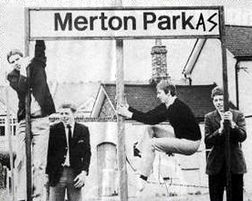 In the 1970's mod band The Merton Parkas used the station for publicity photographs
In the 1970's mod band The Merton Parkas used the station for publicity photographs |
In a further Act in 1856 the LBSCR secured a 21-year lease to operate the line with authorisation to raise capital to double the track if required. However in 1857 with the prospect of LB & SCR trains running into Wimbledon the LSWR revived their interest and obtained Parliamentary authority in 1857 for joint operation securing the Wimbledon—Mitcham section for the remainder of the lease on the understanding that the Brighton could continue to work into Wimbledon. In 1862 a joint committee was set up to manage the line which was later purchased outright from the W & CR by the LB & SCR on 1st January 1866. The LSWR were offered a half share in the venture but declined only retaining an interested in the section shared with their proposed Wimbledon - Tooting route.
On 1st October 1868, the LB & SCR opened their line from Peckham Rye to Sutton, this cut across Mitcham Common turning sharply to join the W & CR where a new shared station at Mitcham Junction was opened, beyond the station the new line diverged to the south and on towards Sutton
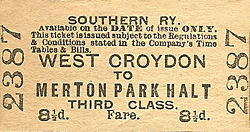 |
The Tooting Merton and Wimbledon Railway also opened on 1st October 1868 from Streatham Junction to Wimbledon, which was approached from two directions by lines diverging at Tooting Junction, one coming into the town from the north-east, the other from the south-east after forming a junction with the Wimbledon & Croydon at Merton. A station called |
Lower Merton was opened at the junction but this initially only had platforms on the Tooting line although a third platform was later added on the Croydon line opening on 1st November 1870
The Croydon line saw few changes before World War I with 12 trains a day in each direction and one railmotor working. The line between Mitcham and Mitcham Junction had been doubled in March 1879, probably to facilitate the working of goods trains to and from the yard at Mitcham which was the only public goods depot on the line. Passenger traffic between Wimbledon and Croydon was very light, Merton Park was the only station that saw even a small increase in residential travel as the area was developed. There was virtually no other housing development along the line before 1914.
Freight traffic gradually assumed more importance between Mitcham and Croydon were a number of sidings were built of which the most noteworthy was the ‘Waddon Marsh New Siding’ serving Waddon Flour Mills on the north bank of the Wandle, a single line of almost a mile running due south from the Croydon end of Beddington Lane. Near this junction, sidings served gravel pits on both sides of the line, those on the south later rearranged for the British Portland Cement Works, the others for a permanent way depot. Another siding, on the north side, a little nearer Croydon entered a brewery and was followed by another into the Croydon Gas, Commercial & Coke Company’s works at Waddon Marsh, west of the line. After 1920, these works expanded to the east side, requiring another set of sidings. Also on that side was Croydon Power Station, rail-served from about 1925 and with its own internal system. In 1948—50 a second and very large power station (Croydon B) was built on the west side of the W & CR north of the gasworks. This too had a large complex of sidings
During WW1 push-and-pull sets of two side-gangway coaches and Stroudley 0-4-2T were introduced as a wartime economy from 1 November 1918. These were manned by conductor guards who issued tickets to those boarding at what were now unstaffed halts at Merton Park (formerly Lower Merton), Morden and Beddington Lane. The booking office at Merton Park reopened in 1923 but Beddington Lane and Morden Road remained unstaffed.
| With the opening of the Northern Line extension to Morden on 13th September 1926 passenger revenue form Merton Park, Morden Road (formerly Morden) and Mitcham declined rapidly although through journeys continued to attract a steady patronage. In 1927 there were 14 push-and-pull workings between Wimbledon and West Croydon, one; extended to |
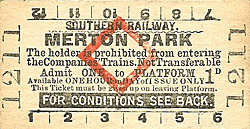 |
Crystal Palace Low Level, two from Wimbledon to Sutton via Mitcham Junction, and another from Mitcham to Crystal Palace Low Level a similar service worked down. The line maintained healthy freight traffic, especially around Croydon and Waddon Marsh.In 1930 during the building of the London County Council's 825-acre St. Helier housing estate the contractors, laid an extensive temporary network of flat-bottom rails on cinder ballast to carry materials as required to the building sites, this being connected to the W&CR through a siding at Mitcham goods yard. This rail network which included 30ft bridge over the River Wandle was operated by six locomotives, shedded at a depot about a mile south of Mitcham. It was one of the last examples in southern England of a major public works contract relying on rail-delivered materials which were carried to site over specially-laid lines.
The W&CR also handled the Southern’s own needs for its permanent way depot on the north side of the line near Beddington Lane and for the civil engineer’s depot next to the goods yard at Mitcham.
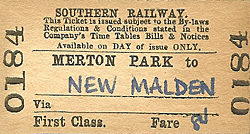 |
Electrification of the Southern's suburban railway network was nearing completion by 1928 and approval was given for electrification of the W & CR on 7th July that year. With the increased frequency of trains after electrification of the line the Southern had to consider how this would affect the handling of the important freight traffic.The existing five booked freight |
workings between West Croydon and Mitcham (two extended to Wimbledon) and one or two daily as far as Waddon Marsh would have to be moved to the night hours to make room for the proposed electric service. As such a change would incur extra costs and inconvenience to customers; it was proposed to construct another track between Beddington Lane and West Croydon to allow daytime freight working to continue. For much of its length this involved joining up already existing sidings to create the new line.
As no corridor electric stock was available for conductor-guard operation, 2-car electric sets were made up from redundant side-gangway first class trailers from the LBSCR’s 1909 overhead stock built for the South London line electrification. After conversion and refurbishment at Peckham Rye works into two car multiple units, they were ready to start work on the newly electrified line on 6 July 1930, operating every 20 minutes at peak times, otherwise half-hourly, seven days a week, and sharing the reconstructed platforms 9 and 10 at Wimbledon with the Wimbledon and Sutton service.
On the opening day of electric service, a new halt was added at Waddon Marsh, attached to the south end of the existing signal box, served by a passing loop. Traversing the whole length in just over 16 minutes, the electric trains passed each other on the double track between Mitcham and Mitcham Junction.
| Although there were two or three patches of new housing between Morden Road and Mitcham by the end of the 1930s, the rural atmosphere was preserved when the extensive area of Morden Hall Park came under the care of the National Trust. From Mitcham to the Junction many small houses were built between 1927 and 1939 and the general residential growth of |
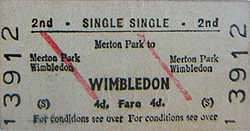 |
the Mitcham area required some improvement to the goods yard in 1936. At Beddington Lane there was a small cluster of new housing close to the station.
The mixed land uses and street transport competition stunted the growth of passenger traffic that normally accompanied suburban electrification. The 2-car sets continued to provide ample accommodation for the traffic offering right through to the 1950’s, when they reached the end of their useful life. In 1954 they gave way to BR 2EPB 2-car sets which brought an end to the conductor-guard operation and ticket issuing arrangements were provided at Morden Road while passengers using Waddon Marsh and Beddington Lane were able to buy tickets from the signalmen.
Freight traffic was still quite heavy in the mid-fifties but by the 60's this was in decline. Mitcham yard closed, from 1 May 1967. After the Croydon gasworks closed, there remained until 1973 two or three daily trips bringing coal from Betteshanger Colliery in Kent to Croydon B power station, but in that year a switch was made to Durham coal brought by coastal vessels to Kings-north (Kent) where it was loaded into lorry loads and taken over congested urban roads to Croydon. This left gas oil for the power station’s auxiliary plant as the only regular freight movement.
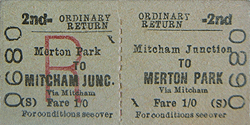 |
The W&CR was early on the list for closure, coming up for the first time in 1951 when it was decided that with freight still important, passenger abandonment did not make much sense, as signaling could not be much reduced so withdrawal of the passenger service would make little difference to operating costs. Instead, there followed a series of economy cuts, starting with |
Sunday closure of Morden Road from 13 September 1964. From 20 June 1965 Sunday trains were withdrawn over the whole line and from 7 November 1966 Morden Road was also closed on Saturdays. This last date also saw curtailment of evening service with last trains brought back to around 7.45pm departures each end instead of 10.45pm. First trains now started at around 7.15am, but frequency remained half-hourly through the shorter day, still with some extras at peak hours (the last of these were eventually withdrawn in May 1971).
park_old9.jpg) Merton Park signal box in 1930 - Photo from Joan Hunt
Merton Park signal box in 1930 - Photo from Joan Hunt |
In common with others on the Southern Region, the halts lost this description in the timetables operative from 5 May 1969. With the drastic reduction in freight, it became possible to work the separate goods line between West Croydon and Beddington as a siding from West Croydon. In 1971 a land slip on the Wimbledon side of the road bridge at Mitcham station resulted in the double track section being cut back to the station and the up platform was taken out of use. BR once again considered closure that year but despite declining passenger numbers there was strong opposition and the line was reprieved after a public enquiry.
A year later, BR issued a poster encouraging people to "ride the line, which remains a useful link between two important suburban centres." After October 1991 the last 'slam door' trains were withdrawn from the line which was then worked by modern air door Class 456 units. |
In 1986 a study was carried out by London Transport and British Rail which covered all of London. From 1990 Croydon Council and London Transport worked to promote a tram network to improve traffic congestion. Public consultations took place during 1991 discussing routes and testing public opinion which resulted in a bill being put before Parliament in November 1991. The Croydon Tramlink Act received Royal Assent on 21st July 1994 giving London Regional Transport the legal power to build and run 'Tramlink'. Three routes were planned, Route 1 running from Elmers End to Wimbledon utilising he entire length of the Wimbledon and West Croydon line.
| By this time the line was in a very dilapidated state with little passenger traffic and all the stations covered in graffiti. Closure was announced for 2nd June 1997 with a special service operating on 31st May to cope with the anticipated crowds. This shuttled backwards and forwards all day but even before closure most of the signage had been removed from the stations to |
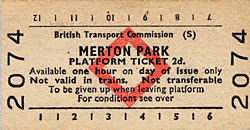 |
deter collectors and the stations took on an air of desolation 1998 followed by the demolition of all the stations with the exception of the 'up' platform and original station building at Mitcham and the station building at Merton Park. All the stations were retained as stops on Tramlink with new platforms with the exception of Waddon Marsh where a new site was selected several hundred yards closer to Croydon.
A variety of problems with the contractors and numerous legal contracts delayed the opening of the new line. The first tram was delivered in October 1998 to the new depot at Therapia Lane and testing on sections of the Wimbledon line began shortly afterwards. The first tram ran through streets of Croydon on 16th June 1999.
The official opening finally took place on 10th May 2000 at New Addington when Route 3 opened to the public. Route 2 to Beckenham Junction opened on 23rd May 2000 with the Route 1 from Elmers End to Wimbledon opening a week later on 29th May 2000.
BRIEF HISTORY OF THE TOOTING MERTON & WIMBLEDON RAILWAY
The Tooting, Merton & Wimbledon Extension Railway obtained an Act on 19 July 1864. This was a nominally independent concern with powers to make working arrangements with both the LB&SCR and the LSWR but a further act of 1865 dissolved the independent company and vesting its line jointly in the LSWR and LBSCR. The Tooting, Merton & Wimbledon Railway opened on 1 October 1868 from Streatham Junction (on the LBSCR Peckham Rye to Sutton line dating from the same day) to Wimbledon, which was approached from two directions by lines diverging at Tooting Junction, one coming into the town from the north-east, the other from the south¬east after forming a junction with the Wimbledon & Croydon Railway at Merton. The northern arm of the loop line reached Wimbledon via a station at Hayden Lane.
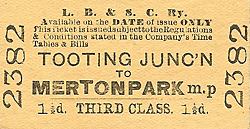 |
The opening of the TMWR via Merton Abbey saw the doubling of the WCR between Wimbledon and the junction at Lower Merton. The line was double track throughout, the line through Merton being justified by promise of freight traffic from the copper mills at Merton Abbey where a siding was provided. At first only LBSCR trains used the TM&W, working |
between London Bridge and Wimbledon by both routes to and from Tooting Junction, but the 1865 Act had given the LSWR running powers to Tulse Hill and on 1 January 1869 a Kingston to Ludgate Hill service was started, this utilised both arms of the TM & W. although most of the twelve daily trains between Kingston and Ludgate Hill ran via the Merton line.
There was two intermediate station on the Merton line at Merton Abbey and Lower Merton and one on the northern branch at Haydons Road, both opened with the line. Lower Merton was at the junction with the W & CR, initially there was only platforms on the Tooting line but a platform was later added on the Croydon line opening on 1st November 1870.
In 1893 of the 16 down trains between London Bridge and Tooting Junction, five continued to Wimbledon via Merton Abbey, returning via Haydon’s Road, the remainder reversing this route. Both routes were well used during rush hours but with the introductions of trams and motor buses after 1910 there was little off peak traffic.
Initially World War I brought few changes to passenger services until 31st December 1916 when services on both sides of the loop were withdrawn to make resources available for essential war transport. The passenger service resumed on 27 August 1923 at a reduced frequency. In 1929 the northern loop was electrified but following the opening of the Northern Line extension to Morden the southern loop had lost much of its traffic to the underground with commuters using Colliers Wood rather than Merton Abbey which closed from 3rd March 1929 when the loop was relegated to freight traffic only From the following day, electric trains ran half-hourly between Wimbledon and Holborn Viaduct seven days a week and the new electric trains quickly won back passengers from road transport.
| The Merton Abbey chord remained busy with freight, but the junction at the Tooting end was severed on 10 March 1934, The up track was removed and the section was worked as a long siding from Merton Park, with control by telephone from instruments in the Merton Abbey goods office. Occasional special passenger workings visited Merton Abbey. In 1936 a |
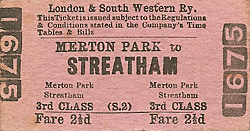 |
supplement to the working timetable indicated that the down platform could be used by excursion trains, but the line was not to be negotiated at more than 5mph, under the supervision of a pilotman.
In the late 1920s and 1930s, Merton saw industrial expansion and a siding was laid from the Merton Abbey track into the new Lines Brothers Triang toy factory in Morden Road. Other private sidings served the Eyre Smelting Works and the New Merton Board Mills at Merton Abbey. As late as 1960 there were still two return goods workings daily from Norwood to Merton Abbey and one on Saturdays to Hackbridge, but with factory closures and increased use of road transport, loadings fell, and after the last revenue train ran coal down to Merton Abbey on 1 May 1975 the track was quickly lifted.
The section of the TM & WR route east of Morden Road was used to construct Merantun Way (A24) in the early 1990's. The road was built to relieve traffic congestion on Merton High Street and was originally planned to continue to the west, along the route of the old railway to Kingston Road, with a flyover across Morden Road. This section of the route was never constructed although the space between the carriageways where Merantun Road meets Morden Road provides the space for a flyover bridge to be constructed. The track bed between Morden Road and Merton Park Station is now a public footpath and nature reserve
Tickets from Michael Stewart, Brian Halford & Nick Catford (2074), 1912 Bradshaw Chris Hind
Sources:
See other web sites: Transport
of Delight for more old pictures of the Wimbledon - West Croydon line and the Unofficial Croydon Tramlink web site
Click on station name for other stations on the Wimbledon - West Croydon line: Morden Road, Mitcham, Mitcham Junction, Beddington Lane, Waddon Marsh
& West Croydon
See also the Tooting Merton & Wimbledon Railway: Merton Abbey, Tooting Junction and Haydons Road.
See also the St. Helier Estate Railway
(West Croydon, Mitcham Junction and Haydons Road are still open but are included for completeness) |

park_old3.jpg)

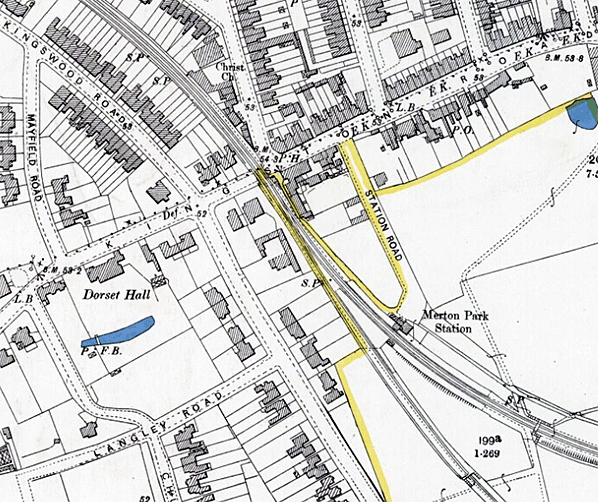
park_old1.jpg)
park56.jpg)
park5.jpg)
park59.jpg)
park26.jpg)
park36.jpg)
park64.jpg)
park72.jpg)










park_old9.jpg)


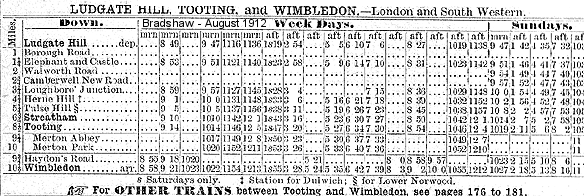


 Home Page
Home Page